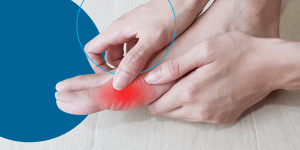What Are Ingrown Toenails?
Are your toes painful and swollen? You might be experiencing ingrown toenails, when your toenail grows into the skin to the right or left of the nail bed. This usually happens in the top corner of your nail and can cause pain, swelling and infection in your toe.
Thankfully, this condition is easy to diagnose and treat. If your ingrown toenail has progressed and is extremely swollen or painful, you should see a doctor right away. The faster you get treatment, the more quickly you can heal and reduce foot pain. Learn more about ingrown toenails, how to treat them at home and when you should see a physician.
Symptoms of Ingrown Toenails
Understanding what an ingrown toenail is can help you treat the source of pain near your toenail. This painful condition is most common on your big toe, although it can happen on other toes as well. Here are the most common symptoms of an ingrown toenail:
- Redness and swelling in the skin at the side of your toenail
- Pain or sensitivity in your toes alongside the nail
- Pus coming from swelling next to your nail
The symptoms you experience will depend on how far along your ingrown toenail condition has progressed. In the early stages of an ingrown toenail, you’ll likely have some redness and pain along your nail. If you don’t take preventive steps at this point, your condition can worsen and lead to swelling and infection.
What Do Ingrown Toenails Look Like?
If your toe is swollen and red around your nail, you might have an ingrown toenail. If an ingrown toenail is untreated, the swelling can expand until the entire side of your toenail is covered. Some ingrown toenails have abnormal-looking nails, with a heavily textured area near the side with the swelling.
What Do Ingrown Toenails Feel Like?
Ingrown toenails affect the soft tissue around your nails. This area of your toe may feel sore or experience sharp pains, depending on how long you’ve had an ingrown toenail. The pain typically gets worse when wearing shoes, walking or putting any pressure on your foot.
Complications of Ingrown Toenails
If you don’t treat ingrown toenails, your symptoms will likely worsen. Unfortunately, this condition doesn’t heal on its own. Complications of ingrown toenails can include:
- Bacterial infection
- Foot ulcers
- Gangrene
If left untreated, this condition can lead to bacterial infections that spread and cause serious damage to your body. If you have additional risk factors like diabetes or poor circulation, ingrown toenails can eventually cause foot ulcers and even gangrene or limb loss.
How to Treat Ingrown Toenails
Thankfully, treating ingrown toenails is easy if you see a doctor right after you notice symptoms. Don’t wait to get help since complications from ingrown toenails can be serious. Here’s more information on home remedies and when to see a medical professional for ingrown toenail treatment.
Safe Home Treatments for Ingrown Toenails
If you suspect you have an ingrown toenail, you should never try to cut it out yourself. This could cause further injury and spread any infection you might have. However, you can try some home remedies to alleviate your symptoms:
- Soak your foot in warm water and Epsom salts several times a day.
- Keep your feet clean and dry when not soaking them.
- Gently lift your nail tip and put cotton underneath to help it grow over the skin.
These home treatments will only work if your nail is just starting to grow into your toe. If you have an advanced case with significant swelling or other symptoms, these treatments likely won’t be enough for your toe to heal on its own.
When Do You Need to See a Doctor for Ingrown Toenails?
If your symptoms are extremely painful or getting worse, you should see a doctor. A podiatrist can diagnose your symptoms and provide professional treatment to relieve pain. In cases where your ingrown toenail is advanced, you may need surgery to remove the damaged nail, treat infection and encourage healthy nail growth again.
Although surgery may sound intense, treating ingrown toenails is a minimally invasive procedure. It’s much better than living with chronic pain or developing a complication like spreading infection or gangrene.
The role of podiatrists in treating ingrown toenails isn’t just to complete surgery, however. A trustworthy podiatrist will only recommend surgery if it’s a necessary last resort. In many cases, they can help you reduce swelling and heal infections so you don’t need surgery to heal. The sooner you call a podiatrist, the less likely you’ll need surgery, so don’t wait!
What Causes Ingrown Toenails?
Several things may cause ingrown toenails, and factors like genetics or diabetes can make them worse. Top risk factors and causes for painful ingrown toenails include:
- Improper foot health and care: If you trim your toenails too short and round the corners, they’re more likely to grow into your toe and cause pain.
- Shoes that are too tight: Wearing tight shoes can also lead to ingrown toenails since your nail will be pushed into your toe.
- Curved or thick toenails: Because some nail shapes and sizes are more likely to grow into your skin, genetics can also impact ingrown toenails.
- Foot or nail injuries: Injuries to your feet, nails and nail bed can increase your risk for ingrown toenails.
- Deformities like bunions: Foot deformities like bunions and hammertoe change your foot shape, increasing the likelihood of ingrown toenails.
Genetics, poor circulation and diabetes also may play a role. If your nails are genetically thick or curved, they’re more likely to injure your toes. Once you have an ingrown toenail, poor circulation or diabetes makes it harder for your body to heal. If you have diabetes, it’s especially important to see a doctor for ingrown toenails.
How to Prevent Ingrown Toenails
You can often prevent ingrown toenails by following several simple steps:
- Trim your toenails straight across.
- Don’t cut your toenails too short.
- Wear comfortable shoes.
- Keep your feet clean and dry.
- See a doctor if you have any pain.
Preventive and early care can keep ingrown toenails from causing you pain. If you notice redness, swelling or tenderness around your toenails, it’s important to see a doctor. Early treatment can help you avoid surgery and stay on your feet without pain.
Treat Ingrown Toenails at Foot & Ankle Surgical Associates
Need a podiatrist to look at your feet? At Foot & Ankle Surgical Associates, we improve patients’ quality of life by reducing ankle and foot pain. Whether you’re dealing with an ingrown toenail, bunions or a fungal infection, we can help you with minimally invasive treatment.
We offer same-day and next-day appointments so you can get the care you need quickly. To make our care more accessible, we accept all insurance. Let us help you put your best foot forward by relieving pain and preventing complications. Call us today at 360-754-3338 or fill out our contact form online to learn more!
Resources linked:
- https://orthoinfo.aaos.org/en/diseases–conditions/ingrown-toenail
- https://fasafw.com/blog/how-to-prevent-and-treat-ingrown-toenails/
- https://fasafw.com/blog/when-should-an-ingrown-toenails-be-seen-by-a-podiatrist/
- https://fasafw.com/blog/how-to-properly-and-safely-trim-your-toenails/
- https://fasafw.com/podiatry/bunion-doctors/
- https://fasafw.com/podiatry/hammertoe-treatment/
- https://fasafw.com/podiatry/ingrown-toenails/
- https://fasafw.com/#email-form




